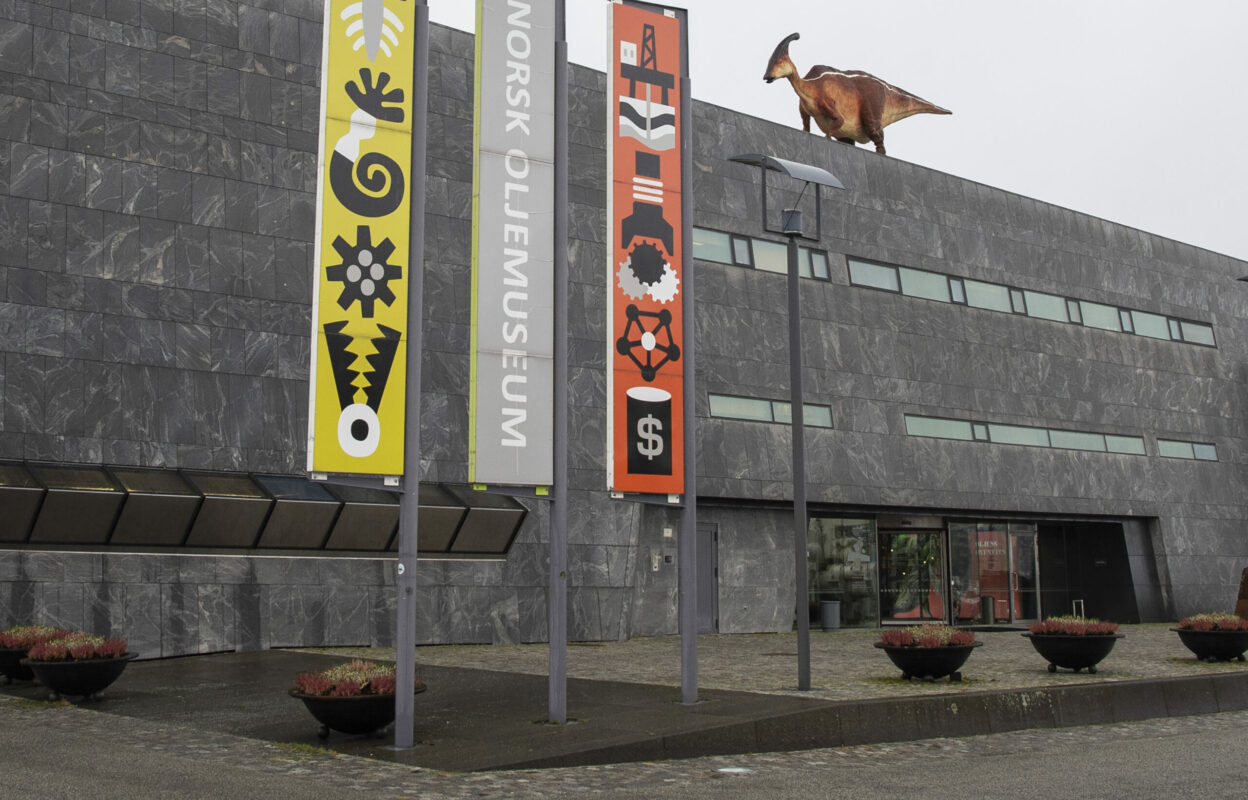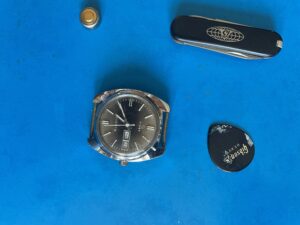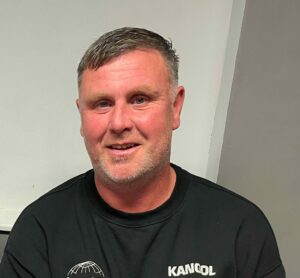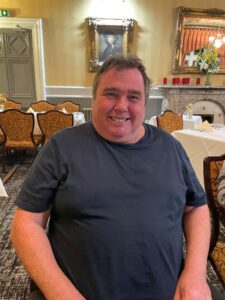Losing a father

This article is from the Norwegian Petroleum Museum’s 2022 year book. The Norwegian version can be read here, along with the other article.
The Norwegian Petroleum Museum was tasked with executing the historic Documentation Project about the Alexander L. Kielland accident. In total, 8 million Norwegian Krone were allocated by the Minstry of Energy and the Ministry of Labour and Social Inclusion. In February 2022, Else M. Tungland started as the project manager for the project spanning three years.
“The surviving relatives did not receive follow-up and the follow-up of the survivors was inadequate.” This is one of the conclusions that the Office of the Auditor General of Norway reached in their report on the investigation of the authorities’ work on the Alexander L. Kielland accident.[REMOVE]Fotnote: The Office of the Auditor General of Norway. (2021). The Office of the Auditor General’s investigation of the authorities’ work on the Alexander L. Kielland accident https://www.riksrevisjonen.no/en/reports2/en-2019-20202/investigation-of-the-authorities-work-on-the-alexander-l.-kielland-accident/
The report was completed 40 years after Norway’s largest industrial accident, where a rig capsized in the North Sea right after Easter 1980. 123 men died and 89 survived.
As the report was presented to the Norwegian Parliament in June 2021 many thought that it would lead to a new investigation of the accident. The Office of the Auditor General concluded that there was not a sufficient basis for a new investigation. The Parliament decided that a historic Documentation Project about the accident was to be initiated.[REMOVE]Fotnote: https://www.stortinget.no/no/Saker-og-publikasjoner/ Vedtak/Vedtak/Sak/?p=83820
One of the aims of the project is:
to contribute to survivors, bereaved and other persons affected by the Alexander L. Kielland accident feeling seen and heard, as well answering any questions that they may have as far as possible.
The Memory Bank
Many of the bereaved have already told their stories, which have been published in the Alexander L. Kielland Memory Bank. It is a collection published by the Stavanger University Library, which consists of over 300 stories divided into five books. The Memory Bank is based on material that was collected in connection with earlier Kielland projects, but there are still stories that have not been heard. In the Documentation Project we will continue allowing those affected to tell their stories which in turn will be published in the Memory Bank. In collaboration with the University Library we are working on translating the remaining books. The entries in the Memory Bank can be read here.
Great Britain
There were eight nationalities aboard the Kielland when the accident took place. The largest non-Norwegian group were British citizens. 20 of these died in the accident. We know little about how those affected were cared for and followed-up. In 2022 the project and the Kielland Network made two trips to Great Britain where they met widows and children of the victims of Kielland. So far we have interviewed two of the survivors and 11 of the 11 families of the casualties in Britain.
Alone in Grief
Deborah Laxon was of the widows we met in Great Yarmouth, a beautiful resort town in Norwich. Long before the petroleum industry dominated the town, fishing and tourism were some of the largest employers.
Deborah was 19 when she in 1980 travelled to Stavanger. It was her first time abroad and she did not even have a passport. She was allowed entry under special circumstances, she had to identify the body of her father, Edward Laxon, who perished in the Kielland accident.
Her mother back in England and was prevented from going herself due to illness. Deborah was given a small satchel containg a watch, a guitar pick and a pocket knife. Her mother kept asking Deborah if she was sure that it was Edward’s body.
Deborah’s mother is now 94 years old. She was never the same after she lost her husband. Doeborah, like many others say that she did not only lose her father in the accident, but also her mother.[REMOVE]Fotnote: Quotes from the Deborah Laxon’s entry in the Memory Bank available at https://ebooks.uis.no/plugins/generic/pdfJsViewer/pdf.js/web/viewer.html?file=/index.php/USPS/catalog/download/10/7/26/?inline=1#page=292


A watch, a guitar pick and a pocket knife helped identify Deborah Laxon’s father. Photo: Deborah Laxon, private photo (left); Else M. Tungland/Norwegian Petroleum Museum (right).
Cleator Moor
On the west coast of Northern England, lies a small town of 7000 inhabitants named Cleator Moor. As the petroleum industry was booming, it led many men into the profession. The pay was after all much better than the local nuclear powerplant in Sellafield.
On of the six men who died was father-of-four, Keith Hunter. His daughter Nicola turned nine the day after the accident. She received a happy birthday card which her father had sent from Kielland. Nicola struggled with accepting the fact that her father would not return. She made up stories that he was still alive and had a new family somwhere far away. When we met her in London during the summer of 2022, she told us that they did not speak much of the accident as she was growing up.
En av de seks mennene fra Cleator Moor, som omkom, var firebarnsfaren Keith Hunter. Datteren hans Nicola, fylte 9 år dagen etter ulykken. Hun fikk da et bursdagskort i posten som faren hadde sendt til henne fra Kielland. At han aldri kom hjem igjen var noe Nicola hadde vanskelig for å fatte. Hun lagde seg historier om at han fortsatt levde og hadde fått seg en ny familie langt borte et sted. Da vi traff henne i London sommeren 2022 fortalte hun at det var lite snakk om ulykken i oppveksten:
“My mother did not tell me about the accident the day it happened. Somebody told me when I went to school the following day. Some other kids had heard the grownups talking about the accident at home. I have never talked about it. Nobody talked to me about it. There was nowhere to go, nobody to talk to. Nowhere to go to keep respect. His body was never found. I still find it hard to believe he is gone.”[REMOVE]Fotnote: Quotes from Nicola Hunter, Memory Bank. https://ebooks.uis.no/plugins/generic/pdfJsViewer/pdf.js/web/viewer.html?file=/index.php/USPS/catalog/download/10/7/26/?inline=1#page=313
Her half-brother, Wayne Hunter, still lives in Cleator Moor. He also tells us of little information and follow-up: “My story is that I was four years old. It’s very vague. When you lose your dad at that age, it brings its own problems. I still have problems. The community tried to protect people, so nobody talked about it. As a child nobody talked to you. They created a smokescreen, a bobble to keep the children safe, but you weren’t safe. It isn’t healthy, I know with my kids if something’s up let’s talk about it. When I grew up, we didn’t talk about it.


Wayne was four years old when he lost his father. His “Dad” tattoo behind his ear reminds him of the father he never got to know. Photo by Else M. Tungland/Norwegian Petroleum Museum.
The rigg going down forty-two years ago, people are still grieving, and I’ve just started. Not because of my dad back then, but because I didn’t know what I lost. I was four, I’ve just started grieving. I thought we deserved better, we needed answers forty-two years ago. The more I learn, the more questions I get.”[REMOVE]Fotnote: Quotes from Wayne Hunter, Memory Bank https://ebooks.uis.no/plugins/generic/pdfJsViewer/pdf.js/web/viewer.html?file=/index.php/USPS/catalog/download/10/7/26/?inline=1#page=319
The stories Deborah Laxon and the Hunters have told us confirm the findings of the Office of the Auditor General, not only in Norway but also Great Britain.
Lessons
According to the Office of the Auditor General, the apparatus for taking care of surivors and bereaved after major accidents and catastrophes has been significantly strengthened after the Kielland accident
“It is now required by law for councils to have plans in order to deal with the psycho-social aftermath in those affected by larger incidents.”[REMOVE]Fotnote: Norwegian Parliament about the Office of the Auditor General. https://www.stortinget.no/no/Saker-og-publikasjoner/Publikasjoner/Innstillinger/Stortinget/2020-2021/inns-202021-577s/?all=true#:~:text=Kielland%2Dulykken%20har%20kommet%20p%C3%A5,til%20%C3%A5%20f%C3%B8lge%20opp%20rammede.
Even though those affected are better taken care of today than they were in 1980, there are lessons to be learned from those affected.
Several have suffered from the lack of information that they received growing up, and are still left with questions unanswered. There are several interviews in the Memory Bank where it can be understood that this was done with the best of intentions in order to shield the children. It was a common perception in the 1980s that the best way deal with sorrow was to power through, forget and move on. Boys were told that “Now you are the man of the house”, and girls were given valium.[REMOVE]Fotnote: Kenneth Hagen Vi som mistet https://ebooks.uis.no/plugins/generic/pdfJsViewer/pdf.js/web/viewer.html?file=/index.php/USPS/catalog/download/10/7/26/?inline=1#page=129; Janne Lia Christensen. Vi som mistet https://ebooks.uis.no/plugins/generic/pdfJsViewer/pdf.js/web/viewer.html?file=/index.php/USPS/catalog/download/10/7/26/?inline=1#page=170
Noen har slitt med manglende informasjon i oppveksten og ikke fått svar på spørsmål. I Minne banken er det flere intervju som kan tyde på at mye av dette nok ble gjort i beste mening. Barna skulle skånes for det som var ondt og vanskelig. En vanlig oppfatning på 1980-tallet var at den beste måten å komme seg gjennom sorgen på var å bite tennene sammen, glemme og gå videre. Gutter ble fortalt at «nå er det du som er mannen i huset» og jenter fikk valium.[REMOVE]Fotnote: Kenneth Hagen og Janne Lia Christensen. Vi som mistet. Eller som en sa det:
“There was little room for grief at the time. We all withdrew to our rooms and grieved separately”[REMOVE]Fotnote: Tone Skristad. Memory Bank. https://ebooks.uis.no/plugins/generic/pdfJsViewer/pdf.js/web/viewer.html?file=/index.php/USPS/catalog/download/10/7/26/?inline=1#page=103
Conversations with those left behind also begs the question about how long it is necessary to follow-up those who lost. Maureen Fleming, widow of Michael Fleming, claims that it might be necessary long after the accident itself.
“My daughter is still paying for therapy at the age of 49, she has paid thousands to therapists because she at 6 years old thouht her dad had abandoned her.”[REMOVE]Fotnote: Maureen Fleming. Memory Bank. https://ebooks.uis.no/plugins/generic/pdfJsViewer/pdf.js/web/viewer.html?file=/index.php/USPS/catalog/download/10/7/26/?inline=1#page=311
Perhaps the need for aftercare and follow-up today would not have been as great today if the children had been helped back in 1980. Many still struggle with the grief and longing. Colin Lamb, named after his father, Colin Lamb from Cleator Moor puts it this way:[REMOVE]Fotnote: Colin Lamb. Memory Bank. https://ebooks.uis.no/plugins/generic/pdfJsViewer/pdf.js/web/viewer.html?file=/index.php/USPS/catalog/download/10/7/26/?inline=1#page=323
Colin Lamb as an adult (left panel), and Colin with his father (right panel). Photo by Else M. Tungland/Norwegian Petroleum Museum (left) and Colin Lamb, private photo (right).
He is there in the dreams. At least I had my first pint with my dad Xmas 1979. I remember that well”.
“I had uncles, but not a dad, that’s not the same. It is something you missed in life, a dad. I feel like he left us and never came back.
Those who lost their fathers in the Alexander L. Kielland accident can teach us how children experience a traumatic experience, what kind of help they need and how such an experience affects their lives. The need for support shortly after the experience or incident is well known, but there is more to learn about long term consequences.
arrow_backThe Red Survival SuitOpening the Archivesarrow_forward


